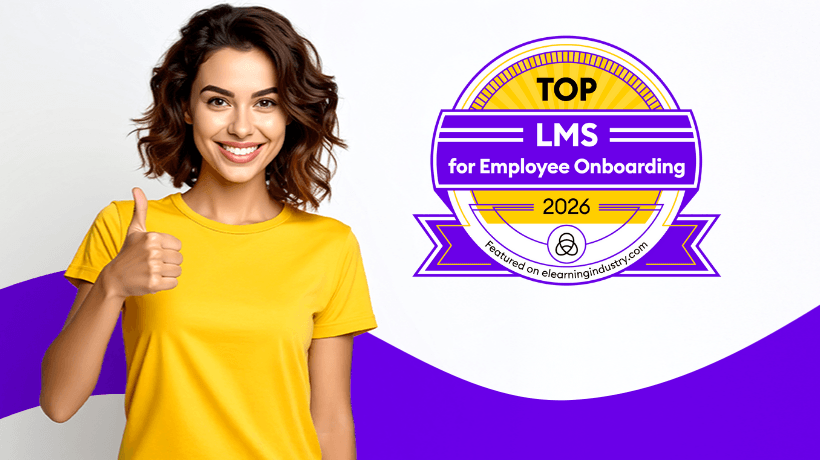The Top 20 Characteristics Of Great Onboarding eLearning
It’s been estimated that as many as 1 in 3 people leave their organization within the first year (Wynhurst Group 2007, SHRM Presentation) and that 22% of staff turnover happens within the first 6 weeks of staff joining (PWC: Best practices for retaining new employees report). The cost to an organization of losing an employee within the first 12 months can be as high as three times their salary cost. According to PWC, that’s around £42bn in UK industry alone.
Little wonder organizations are looking again at their onboarding program. A major reason for investing in formal onboarding is to improve retention. So what does a ‘good’ onboarding program look like? In this article I’ll explore some of the characteristics that have been present in some of the best onboarding programs I’ve seen or worked on. These are my Top Twenty (in no particular order).
- Blended Learning.
Learning is part of an overall blend of delivery methods that may include, but is by no means be restricted to the following: face-to-face sessions with technical experts; one-to-one sessions with managers and colleagues; online trainer led sessions (e.g. webinars); self-directed activities and diagnostics. - Valuable.
Onboarding eLearning adds value to the overall program, for example a two-day face-to-face training segment could be reduced to one, and complimented with eLearning. Consider whether your current provision relies on a trainer to communicate your organization’s policies. If so, could you put your policies online for new starters to access at any time and use the face-to-face session to highlight key areas or address soft skills your new starters may need to practice before heading out into their new roles? - Scalable.
How many new starters need to be onboarded into the organization annually? Are new starters recruited at set times throughout the year or continually joining? Are they all in one office? In one country? One time zone? Onboarding eLearning is easily scalable to fit demand in a way that getting trainers to different offices, sites or even countries just isn’t. Even with online training events, it can be challenging if your new starters are widely distributed. Asynchronous eLearning is an effective alternative. - Cost effective.
Onboarding eLearning reduces costs by helping onboard people in their locations – no expensive travel required - and by reducing labour intensive manual processes. - Extensible.
Takes future growth and transition into account. Onboarding eLearning can be adapted, enhanced and extended with relative ease, given the availability of rapid, easy to use onboarding development tools. - On-brand and brimming with your values.
Give it personality, visual or emotional, a branded story that people can connect with. Make it a talking point between people. eLearning templates can be set up to reflect the brand values. Once set-up, the theme can be deployed quickly and easily across all your eLearning. - Attractive.
Good-looking, with the right tone. By incorporating onboarding eLearning, you can have your creative talent set up templates with a sophisticated, professional look and feel that can be deployed easily across all your eLearning products. Design once, build many times. - Authentic.
Make the onboarding experience real, scenario, use real contexts that your new starter will encounter in their role. Incorporate existing staff’s voices. Onboarding eLearning is great for capturing anecdotes, stories, hints and tips straight from the horse’s mouth. It gives you an opportunity to put your best talent in front of all your new staff, convey a consistent message. It also gives folk the opportunity to get a feel for your organization’s values and culture before they even start. - Relevant.
Give your new recruits what they need in the FIRST week of starting – what they need for the rest of the first year can be done in separate training programs. They won’t all need to know everything, and onboarding eLearning can provide a great way for new starters to get straight to a menu of options, helping you avoid your onboarding program being a one-size-fits-all sheep dip experience. - Measurable.
Converting elements of your program to eLearning will help reduce the time to competency for your new starters by reducing time away from job whilst increasing productivity. You should also be able to measure the success of the onboarding program in reduced rates of attrition. - Consistent.
eLearning helps make your onboarding program consistent across divisions and geographic regions. Consistent in design, message and branding. Set your course up as a ‘Master’ and roll it out across all your regions quickly and easily. - Engaging.
Promote engagement by creating an experience, not training. Good onboarding courses use high-engagement approaches such as games, scenarios and simulations to hook new starters’ attention and keep the pace up. eLearning can provide short, welcoming and informative resources, and support the new hires through their onboarding journey. - Personal.
Make it personal not mandatory by giving folk different tracts through the program according to needs and provide performance support in context. eLearning can really push you forward here e.g. sales tips can be deployed onto a sales rep’s mobile phone and be available just before he or she goes into their first client meeting. - Modular.
A program that is granular provides greater flexibility for deployment and supports a more learner-driven experience, as well as providing just-in-time (JIT) training segments. - Performance Focused
Focused on performance and behaviors, not just learning. - Outcomes-based and Practice-oriented
Making the learning experience and tasks closer to what the person will do in their day-to-day role; designed with key competencies driving the learning objectives and with practice tasks linked to skills the new starter will need in role. Avoid tasks or contexts that are abstract or theoretical. The best courses provide fully simulated tasks and a ‘walled garden’ environment so people can make mistakes safely, practice as much they need and learn from mistakes. - Empathetic.
Design a ‘buddy’ figure, conversational, empathetic – a friendly face who understands what it is new starters will want to know first as they begin. You can pre-empt a lot of the frequently asked questions of new starters by surveying your most recent recruits and then capture these and responses into eLearning with the voice of the ‘buddy’ character. - Functional and Aligned.
Capture informal as well as formal learning and provide practice tasks, social platforms, diagnostic tools to help your new recruits get access to all the tacit knowledge quickly. - Responsive.
Make it work on multiple platforms and devices and take advantage of BYOD (bring-your-own-device). Make it easy for your new starters who are keen to swot up out of hours. - Accessible.
Last but not least and best still is to implement a customized online platform for managing, delivering and measuring the whole of your blended onboarding program. Come on, get it online!
Was this post useful? Do you have any other points to add to the great onboarding eLearning checklist? Let me know in the comments below!
Last but not least, I highly encourage you to read the article The Anatomy Of Great Onboarding eLearning that features the most important aspects of onboarding and share our 4 part framework for creating great onboarding eLearning.









